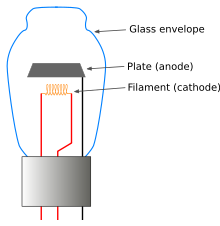Tube diode
A tube diode or vacuum diode (older name by John Ambrose Fleming : kenotron ) is generally an electron tube with two electrodes . In the narrower sense, only evacuated tubes with a heated cathode are referred to as tube diodes. The X-ray tube and the magnetron are in principle also tube diodes.
Historical
In 1873, Frederick Guthrie discovered that a positively charged electroscope would discharge if you brought a grounded, glowing piece of metal near it. If the electroscope is negatively charged, nothing happens, which means that the electric current can only flow in one direction. Thomas Edison rediscovered this phenomenon in 1880 during experiments with incandescent lamps and had the effect patented in 1884 without knowing a possible application. Since then it has been called the Edison-Richardson Effect .
About twenty years later, John Ambrose Fleming , who was first an employee of Edison and later a scientific adviser to the Marconi Wireless Telegraph Company , realized that the Edison effect could be used to detect weak radio signals. He patented the first usable application, the “Fleming valve”, in 1904.
Working principle
Electrons emerge from the cathode due to field emission , photo emission , or (if the cathode is heated) thermal emission and can be captured by the anode . This electrical current is particularly high when the anode is at positive voltage with respect to the cathode . If the anode voltage is high enough, all electrons emerging at the cathode are drawn to the anode and there generate the highest possible current under the prevailing operating conditions, the saturation current . When the anode voltage is lower, many electrons collect near the cathode and form a repelling negative space charge , which hinders the escape of further electrons to such an extent that only the electrons flowing to the anode are replaced ( space charge-limited anode current ).
If the voltage at the anode is negative, the current decreases because only the electrons can overcome the potential barrier that have emerged from the cathode with sufficient energy. With hot cathodes , the anode current drops to zero at a reverse voltage of just a few volts, even at temperatures around 2000 ° C. Therefore, an electron tube with a hot cathode has the effect of a rectifier (see diode ).
Even with an anode voltage of 0 V, a small current flows due to the concentration gradient of the electrons emitted thermally or by the external photo effect. Photocells - which in principle are also tube diodes - can therefore be used for light measurement, similar to semiconductor-based photodiodes , even without an auxiliary voltage source. With the thermionic generator , this effect is used to generate electrical energy from the thermal energy of the glowing cathode.
Use as a rectifier
Tube diodes with a hot cathode were previously used, among other things, in devices with tubes, such as B. the so-called people's receiver with the tube VY2, used as rectifier and demodulator diodes , but later replaced by selenium and finally by silicon diodes with significantly lower losses.
In the case of tube rectifiers, the maximum size of the charging capacitor must not be exceeded and the minimum series resistance (e.g. resistance of the transformer winding) must not be undercut, as otherwise the service life of the cathode coating is reduced beyond the usual wear and tear due to the high current peaks.
Designs
Vacuum tubes

WI1 5/20 (high voltage
rectification ) PY88 (booster diode from TV )
EY51 (high voltage generation in SW-TV)

300… 500 V reverse voltage, max. 0.2 A anode current The cathode strips are located
in the two gray-blue sheet metal sleeves made of P2 iron (anodes) in a W-shape
In practice, a distinction is made between single and dual diodes. These two groups are in turn divided into low-power diodes for demodulator purposes and power diodes for rectifying supply voltages.
| group | Code letter | application |
|---|---|---|
| Single diode | A. | Demodulator purposes |
| Duo diode | B. | Demodulator purposes |
| Single diode | Y | Half-wave rectifier |
| Duo diode | Z | Full wave rectifier |
Diodes for demodulator purposes are often combined with an amplifier triode in one bulb, for example in the EAF42, EBC91 or EBF89.
Single diode
Individual diodes (code letter A or Y) contain only one cathode and one anode. You were z. B. used for one-way rectification, as a booster diode and for high voltage generation on horizontal deflection stages of tube televisions or for amplitude demodulation.
Special types of rectifier tubes have been developed for high voltage rectification (6 to several 100 kV): to avoid field emission , they have rounded anode edges and a greater distance between anode and cathode. You also need an insulated heating voltage source for indirect heating; one of the heating coil connections is connected to the cathode.
Another, obsolete name for high voltage rectifier tubes is glow valve .
Common single diodes with miniature bases were the EY80 and EY82 as well as the high-voltage rectifier diode DY86.
Double diode (duodiode)
Double diodes (code letter B or Z) are tubes with two anodes and a common cathode. They were with independent generation in receivers for amplitude demodulation control voltage used as well as in relation rectifiers for FM - demodulation .
A transformer with a center tap of the secondary winding is used for rectification purposes, so that two-way rectification is possible. The antiphase ends of the anode voltage winding of the transformer are each connected to an anode. The positive pole of the rectified voltage is created at the cathode, the center tap of the transformer winding forms the negative pole. If the cathode is directly heated, a separate, insulated heating winding must be available on the transformer for the heating voltage.
Examples of two-way rectifier tubes are, in addition to the AZ12 shown (directly heated), the types EZ80 and EZ81 (both are indirectly heated, so no separate heating coil is required on the transformer).
The EAA91 (equivalent types EB91, 6AL5, 6H2P, D2M9, D77, 6D2, 6B32, CV283, 6X2П and E91AA) have two independent single diodes in one bulb - the cathodes are electrically separated. The same goes for the EYY13.
Gas-filled rectifier tubes
Mercury cathode rectifiers
Mercury vapor rectifiers are tubes filled with mercury and noble gas with an unheated mercury pond cathode. They are therefore not part of the tube diodes in the narrower sense. They were used for rectifier systems with higher power instead of tube diodes, because they are more effective - they have a lower voltage drop in the forward direction , which is also reflected, among other things, in lower fluctuations in the output voltage with different loads.
Gas-filled rectifier with hot cathode
Gas-filled glow valves contain mercury vapor and, like vacuum valves, have a heated cathode that emits electrons. The electrons in turn ionize the mercury atoms, which, through their positive charge, cancel the negative space charge around the cathode. This results in an increase in performance and efficiency: the forward voltage is a few tens of volts even with a higher current due to an arc discharge immediately igniting by the electrons, and the reverse voltage remains almost unaffected - it is around 30 kV with an electrode gap of 10 mm. Typical applications are rectifiers for tube transmitters. These diodes can be controlled by an additional electrode (see thyratron ).
A kind of cascade made of tubular auxiliary electrodes enables the reverse voltage to be increased to several 100 kV.
With the types AX1 and AX50, small double diodes were also created, which were supposed to combine the advantages of the mercury vapor rectifier with the easy handling of the vacuum diodes. Because of the high-frequency interference caused by the gas discharge, these tubes were only used in the power supply of powerful audio amplifiers.
Individual evidence
- ^ Road to the Transistor . Jmargolin.com. Retrieved September 22, 2008.
- ↑ a b A. Bouwers: Electrical extra high voltages ; Springer-Verlag new edition / reprint 2013; 333 pages; Page 222ff



